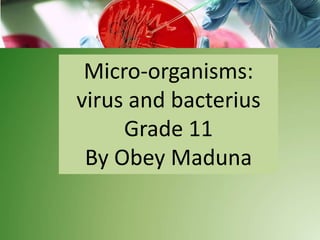
Unit 1 microorganisms students
- 1. Micro-organisms: virus and bacterius Grade 11 By Obey Maduna
- 2. MICRO ORGANISMS Microorganisms are very small life forms (ultramicroscopic) Microscope examination Microbiology: The study of micro- organisms and their interactions with the environment and other life forms.
- 3. IMPORTANT MICROORGANISMS: Groups: VIRUSES BACTERIA FUNGI PROTISTA
- 4. VIRUSES Are “substances” that cause diseases and can be transmitted between organisms. Acellular????? Obligated intracellular parasites?? Outside the host – virus metabolically inert.
- 5. All virus particles consist of two parts : a central core of a nucleic acid strand (DNA/RNA) surrounded by a protein covering called a capsid. nucleocapsid
- 6. Some viruses - additional covering external to the capsid – called the envelope Virus with envelope - enveloped viruses and those without it = naked viruses. Envelope can have accessory structures.
- 7. The capsid consist of sub-units called capsomeres. The capsomeres have perfect geometric shapes. Depending on the shape and arrangement of these capsomeres, two types of capsids may be identified, namely helical and Icosahedral capsids
- 8. Helical and Icosahedral capsids
- 9. What criteria are used to classify a virus? geometry of the virus, whether they have envelopes the identity of the organism they infect transmission mode the disease they cause the type of nucleic acid.
- 10. Patterns of viral replication 1. The lytic cycle. Viruses enter a cell, replicate, and then cause the cell to burst, releasing new viruses. 2. The lysogenic cycle. Viruses enter a long term relationship with their host cells. Their nucleic acid replicates as the host cells multiply. D:Chapter_19A_PowerPoint_Lectures19_Lecture_Presentation1906LysogenicLyticCyclesA.ht ml
- 12. DIFFERENCE BETWEEN LYTIC AND LYSOGENIC CYCLES
- 13. The replication cycle of a bacteriophage (T4) • Bacteriophage: A virus that attacks bacteria cells.
- 14. HIV • Retroviruses use reverse transcriptase to copy their RNA genome into DNA • HIV (human immunodeficiency virus) is the retrovirus that causes AIDS (acquired immunodeficiency syndrome)
- 15. HIV REPRODUCTION
- 16. BACTERIA • Microscopic, unicellular prokaryote????. • Most are heterotrophic but some are capable to photosynthesize. • With respect to their oxygen requirement – 3 types: aerobic ( need oxygen to survive) facultative (can survive with or without oxygen) anaerobic (oxygen will kill these bacteria).
- 17. Structure of a bacterial cell • Flagellum: motility of cell • Pilli: help with conjugation • Cell envelope: consist of the glycocalyx, cell wall and plasma membrane – protection • Slime capsule: protect against loss of water and stomach/soil acids. • Cell wall: consist of peptidoglycan – maintain shape of cell. • Plasma membrane: selective barrier that allows oxygen, nutrients and wastes through cell. • Nucleoid: consist of DNA - form chromatic bodies/plasmids. Genetic information for reproduction. • Ribosomes: complexes that make proteins (rRNA)
- 19. Bacteria are classified according to their shape and arrangement
- 20. Reproduction and life cycle of bacteria • They reproduce asexually by : budding and/or simple binary fission • There is no mitosis. • They generally gave a single chromosome. • Genetic exchange may occur through conjugation.
- 21. Budding of bacteria. • Cell's genetic information is duplicated, creating an identical copy or clone of the original cell. • As the new cell pinches off or buds from the surface, a bud scar is produced.
- 22. Binary fission of bacteria
- 23. IMPORTANCE OF BACTERIA ECONOMICALLY • Sulphur oxidizing bacteria can break down copper sulphide into copper sulphate for copper oar mining. • Fermentation bacteria is used to produce cheese, yogurt, buttermilk….. • Lactobacillus is used to make cheese. • Vinegar is made when wine/cider is fermented by acetic acid bacteria.
- 24. IMPORTANCE OF BACTERIA AS PATHOGENS CAUSE DISEASES SUCH AS: • Diphtheria: Bacteria affecting the pharynx – transmitted through coughing or sneezing. • Tuberculosis: Bacteria that attack the lungs – transmitted through saliva • Plague: Bacteria that infects the lymph nodes – transmitted to man from flee bites (flees come from rodents).
- 25. IMPORTANCE OF BACTERIA ECOLOGICALLY • Bacteria form part of the nitrogen cycle (denitrifying -, nitrifying – and nitrogen-fixed bacteria) • Bacteria are also involved in the sulfur and phosphorous cycles. • Bacteria act as saprophytes – break down complex organic molecules into simple inorganic molecules. • In rural areas bacteria is used in septic tanks to help to dispose of sewage.
